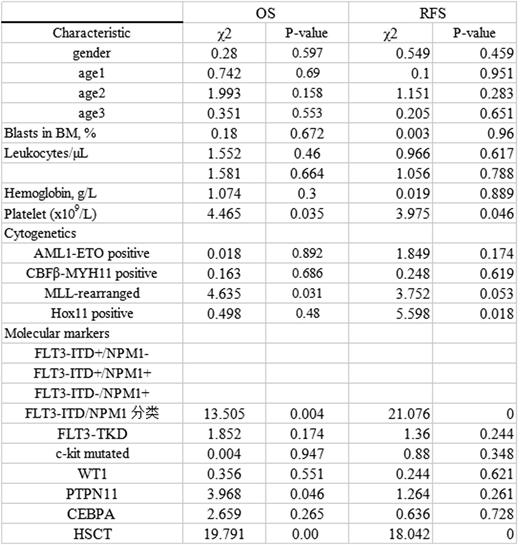Abstract
Objective: To describe the epidemiological profile, cytogenetic and molecular aberrations and the survival rate of patients with acute myeloid leukemia (AML) in a province reference pediatric hospital and explore their clinical features and prognosis.
Patients and Methods: This is aretrospective Clinical-epidemiological study. The cohort of this study included cases of newly-diagnosed pediatric patients with non-M3- AML between 2010 and 2015, with the age younger than 14 years. The clinical characteristics such as gender, age, subtype of FAB, blood routine, bone marrow blast at the first visit, cytogenetics and molecular markers were analyzed in correlation with their prognosis between different characteristics groups. Survival analyses were calculated by Kaplan-Meier survival curves and the log rank test. Multivariate analyses on categorized data were performed using Cox proportional hazards model.
Results: Of the 165 patients studied, 42.4% were females and 57.6%, males, with a age younger than 1 year in 4.8%, from 1 to 10 years in 73.4%, and older than 10 years in 21.8% ( median age 6.8 years ). According to FAB subtype, the majority subtypes were M2, M4 and M5, for 42%, 21.3% , and 26% respectively. 40.6% of patients presented a WBC count below 10 X 109/L at diagnosis while 12.7% of patients higher than 100 X 109/L. 77.0% of patients had less than 90g/L hemoglobin, and 47.9% of patients had less than 50 X 109/L platelets. In 70.0% of patients, the percentage of blasts in bone marrow was higher than 50% at diagnosis. The most common cytogenetic abnormalities in these children, including t(8;21)(q22;q22), inv(16)(p13.1q22) and 11q23/MLL-rearranged abnormalities were detected, with the occurrence of 34.1% , 12.2% and 14.0% respectively. The recurrent gene mutations rates are as the follows: 2.0% FLT3-ITD negative and NPM1 mutated, 4.9% FLT3-ITD positive and NPM1 wild type, 2.0% FLT3-ITDpositive and NPM1mutated, 3.9% FLT3-TKDpositive, 18.6% c-KIT mutation, and 2.9% PTPN11 mutation. Among the 165 cases of non-M3-AML patients, 114 cases achieved complete remission (CR) (69.1%) after one course of chemotherapy, 36 cases were relapsed, and 51 patients accepted hematopoietic stem cell transplantation (HSCT). The 3-year relapse-free survival (RFS) and overall survival (OS) rates were (62.5±3.5)% and (70.6%4±4.6)%, respectively. We failed to correlate the OS with the clinical parameters, such as gender, age, WBC, hemoglobin, blasts in BM, cytogenetic abnormalities except MLL-rearrangements, and gene mutations except FLT3-ITD and PTPN11 mutations . The patients with high platelet count, MLL -rearrangements, FLT3-ITD or PTPN11 mutation exhibited a significantly low OS rate (P£¼£¼(Table 1). Meanwhile, the RFS rate was correlated with the platelet count, FLT3-ITDand HSCT. respectively (Table 1). Multivariate analysis demonstrated that higher platelet count at diagnosis, MLL-rearrangements, FLT3-ITD and PTPN11 mutation were risk prognostic factors in childhood AML, while HSCT was a favorable factor.
Conclusion:Higher platelet count at diagnosis, MLL-rearranged abnormalities, FLT3-ITD and PTPN11 mutation were poor prognostic markers in pediatric AML. HSCT could effectively improve the clinical outcome of AML patients.
No relevant conflicts of interest to declare.
Author notes
Asterisk with author names denotes non-ASH members.


